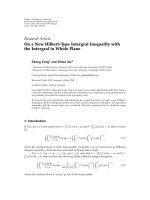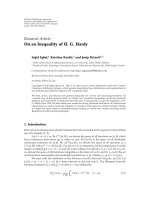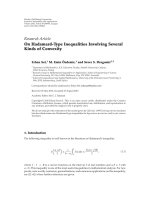Báo cáo hóa học: " Research Article On Some New Sequence Spaces in 2-Normed Spaces Using Ideal Convergence and an Orlicz Function" pptx
Bạn đang xem bản rút gọn của tài liệu. Xem và tải ngay bản đầy đủ của tài liệu tại đây (478.49 KB, 8 trang )
Hindawi Publishing Corporation
Journal of Inequalities and Applications
Volume 2010, Article ID 482392, 8 pages
doi:10.1155/2010/482392
Research Article
On Some New Sequence Spaces in
2-Normed Spaces Using Ideal Convergence and
an Orlicz Function
E. Savas¸
Department of Mathematics, Istanbul Ticaret University,
¨
Usk
¨
udar, 34672 Istanbul, Turkey
Correspondence should be addressed to E. Savas¸,
Received 25 July 2010; Accepted 17 August 2010
Academic Editor: Radu Precup
Copyright q 2010 E. Savas¸. This is an open access article distributed under the Creative Commons
Attribution License, which permits unrestricted use, distribution, and reproduction in any
medium, provided the original work is properly cited.
The purpose of this paper is to introduce certain new sequence spaces using ideal convergence and
an Orlicz function in 2-normed spaces and examine some of their properties.
1. Introduction
The notion of ideal convergence was introduced first by Kostyrko et al. 1 as a generalization
of statistical convergence which was further studied in topological spaces 2.More
applications of ideals can be seen in 3, 4.
The concept of 2-normed space was initially introduced by G
¨
ahler 5 as an interesting
nonlinear generalization of a normed linear space which was subsequently studied by many
authors see, 6, 7. Recently, a lot of activities have started t o study summability, sequence
spaces and related topics in these nonlinear spaces see, 8–10.
Recall in 11 that an Orlicz function M : 0, ∞ → 0, ∞ is continuous, convex,
nondecreasing function such that M00andMx > 0forx>0, and Mx →∞as
x →∞.
Subsequently Orlicz function was used to define sequence spaces by Parashar and
Choudhary 12 and others.
If convexity of Orlicz function, M is replaced by Mx y ≤
MxMy, then this
function is called Modulus function, which was presented and discussed by Ruckle 13 and
Maddox 14.
Note that if M is an Orlicz function then Mλx ≤ λMx for all λ with 0 <λ<1.
2 Journal of Inequalities and Applications
Let X, · be a normed space. Recall that a sequence x
n
n∈N
of elements of X is called
to be statistically convergent to x ∈ X if the set Aε{n ∈ N : x
n
− x≥ε} has natural
density zero for each ε>0.
A family I⊂2
Y
of subsets a nonempty set Y is said to be an ideal in Y if i ∅∈I; ii
A, B ∈Iimply A ∪ B ∈I; iii A ∈I,B ⊂ A imply B ∈I, while an admissible ideal I of Y
further satisfies {x}∈Ifor each x ∈ Y , 9, 10.
Given I⊂2
N
is a nontrivial ideal in N. The sequence x
n
n∈N
in X is said to be I-
convergent to x ∈ X, if for each ε>0thesetAε{n ∈ N : x
n
− x≥ε} belongs to I,
1, 3.
Let X be a real vector space of dimension d, where 2 ≤ d<∞. A2-normonX is a
function ·, · : X × X → R which satisfies i x, y 0 if and only if x and y are linearly
dependent, ii x, y y, x, iii αx, y |α|x, y,α∈ R,andiv x, y z≤x, y
x, z. The pair X, ·, · is then called a 2-normed space 6
.
Recall that X, ·, · is a 2-Banach space if every Cauchy sequence in X is convergent
to some x in X.
Quite recently Savas¸ 15 defined some sequence spaces by using Orlicz function and
ideals in 2-normed spaces.
In this paper, we continue to study certain new sequence spaces by using Orlicz
function and ideals in 2-normed spaces. In this context it should be noted that though
sequence spaces have been studied before they have not been studied in nonlinear structures
like 2-normed spaces and their ideals were not used.
2. Main Results
Let Λλ
n
be a nondecreasing sequence of positive numbers tending to ∞ such that λ
n1
≥
λ
n
1,λ
1
0andletI be an admissible ideal of N,letM be an Orlicz function, and let
X, ·, · be a 2-normed space. Further, let p p
k
be a bounded sequence of positive real
numbers. By S2 − X we denote the space of all sequences defined over X, ·, ·.Now,we
define the following sequence spaces:
W
I
λ, M, p,
, ·,
x ∈ S
2 − X
: ∀ε>0
n ∈ N :
1
λ
n
k∈I
n
M
x
k
− L
ρ
,z
p
k
≥ ε
∈ I
for some ρ>0,L∈ X and each z ∈ X
,
W
I
0
λ, M, p,
, ·,
x ∈ S
2 − X
: ∀ε>0
n ∈ N :
1
λ
n
k∈I
n
M
x
k
ρ
,z
p
k
≥ ε
∈ I
for some ρ>0, and each z ∈ X
,
Journal of Inequalities and Applications 3
W
∞
λ, M, p,
, ·,
x ∈ S
2 − X
: ∃K>0s.t. sup
n∈N
1
λ
n
k∈I
n
M
x
k
ρ
,z
p
k
≤ K
for some ρ>0, and each z ∈ X
,
W
I
∞
λ, M, p,
, ·,
x ∈ S
2 − X
: ∃K>0s.t.
n ∈ N :
1
λ
n
k∈I
n
M
x
k
ρ
,z
p
k
≥ K
∈ I
for some ρ>0, and each z ∈ X
,
2.1
where I
n
n − λ
n
1,n.
The following well-known inequality 16, page 190 will be used in the study.
If 0 ≤ p
k
≤ sup p
k
H, D max
1, 2
H−1
2.2
then
|
a
k
b
k
|
p
k
≤ D
|
a
k
|
p
k
|
b
k
|
p
k
2.3
for all k and a
k
,b
k
∈ C.Also|a|
p
k
≤ max1, |a|
H
for all a ∈ C.
Theorem 2.1. W
I
λ, M, p, , ·, ,W
I
0
λ, M, p, , ·, , and W
I
∞
λ, M, p, , ·, are linear spaces.
Proof. We will prove the assertion for W
I
0
λ, M, p, , ·, only and the others can be proved
similarly. Assume that x, y ∈ W
I
0
λ, M, , ·, and α, β ∈ R,so
n ∈ N :
1
λ
n
k∈I
n
M
x
k
ρ
1
,z
p
k
≥ ε
∈ I for some ρ
1
> 0,
n ∈ N :
1
λ
n
k∈I
r
M
x
k
ρ
2
,z
p
k
≥ ε
∈ I for some ρ
2
> 0.
2.4
4 Journal of Inequalities and Applications
Since , ·, is a 2-norm, and M is an Orlicz function the following inequality holds:
1
λ
n
k∈I
n
M
αx
k
βy
k
|
α
|
ρ
1
β
ρ
2
,z
p
k
≤ D
1
λ
n
k∈I
n
|
α
|
|
α
|
ρ
1
β
ρ
2
M
x
k
ρ
1
,z
p
k
D
1
λ
n
k∈I
n
β
|
α
|
ρ
1
β
ρ
2
M
y
k
ρ
2
,z
p
k
≤ DF
1
λ
n
k∈I
n
M
x
k
ρ
1
,z
p
k
DF
1
λ
n
k∈I
n
M
y
k
ρ
2
,z
p
k
,
2.5
where
F max
⎡
⎣
1,
|
α
|
|
α
|
ρ
1
β
ρ
2
H
,
β
|
α
|
ρ
1
β
ρ
2
H
⎤
⎦
. 2.6
From the above inequality, we get
n ∈ N :
1
λ
n
k∈I
n
M
αx
k
βy
k
|
α
|
ρ
1
β
ρ
2
,z
p
k
≥ ε
⊆
n ∈ N : DF
1
λ
n
k∈I
n
M
x
k
ρ
1
,z
p
k
≥
ε
2
∪
n ∈ N : DF
1
λ
n
k∈I
n
M
y
k
ρ
2
,z
p
k
≥
ε
2
.
2.7
Two sets on the right hand side belong to I and this completes the proof.
It is also easy to see that the space W
∞
λ, M, p, , ·, is also a linear space and we now
have the following.
Theorem 2.2. For any fixed n ∈ N, W
∞
λ, M, p, , ·, is paranormed space with respect to the
paranorm defined by
g
n
x
inf
⎧
⎨
⎩
ρ
p
n
/H
: ρ>0 s.t.
sup
n
1
λ
n
k∈I
n
M
x
k
ρ
,z
p
k
1/H
≤ 1, ∀z ∈ X
⎫
⎬
⎭
. 2.8
Proof. That g
n
θ0andg
n
−xgx are easy t o prove. So we omit them.
Journal of Inequalities and Applications 5
iii Let us take x x
k
and y y
k
in W
∞
λ, M, p, , ·, .Let
A
x
ρ>0:sup
n
1
λ
n
k∈I
n
M
x
k
ρ
,z
p
k
≤ 1, ∀z ∈ X
,
A
y
ρ>0:sup
n
1
λ
n
k∈I
n
M
y
k
ρ
,z
p
k
≤ 1, ∀z ∈ X
.
2.9
Let ρ
1
∈ Ax and ρ
2
∈ Ay, then if ρ ρ
1
ρ
2
, then, we have
sup
n
1
λ
n
n∈I
n
M
x
k
y
k
ρ
,z
≤
ρ
1
ρ
1
ρ
2
sup
n
1
λ
n
k∈I
n
M
x
k
ρ
1
,z
ρ
2
ρ
1
ρ
2
sup
n
1
λ
n
k∈I
n
M
y
k
ρ
2
,z
.
2.10
Thus, sup
n
1/λ
n
n∈I
n
Mx
k
y
k
/ρ
1
ρ
2
,z
p
k
≤ 1and
g
n
x y
≤ inf
ρ
1
ρ
2
p
n
/H
: ρ
1
∈ A
x
,ρ
2
∈ A
y
≤ inf
ρ
p
n
/H
1
: ρ
1
∈ A
x
inf
ρ
p
n
/H
2
: ρ
2
∈ A
y
g
n
x
g
n
y
.
2.11
iv Finally using the same technique of Theorem 2 of Savas¸ 15 it can be easily seen
that scalar multiplication is continuous. This completes the proof.
Corollary 2.3. It should be noted that for a fixed F ∈ I the space
W
∞
F
λ, M, p,
, ·,
x ∈ S
2 − X
: ∃K>0 s.t. sup
n∈N−F
1
λ
n
k∈I
n
M
x
k
ρ
,z
p
k
≤ K
for some ρ>0, and each z ∈ X
,
2.12
which is a subspace of the space W
I
∞
λ, M, p, , ·, is a paranormed space with the paranorms g
n
for
n
/
∈ F and g
F
inf
n∈N−F
g
n
.
Theorem 2.4. Let M,M
1
,M
2
, be Orlicz functions. Then we have
i W
I
0
λ, M
1
,p,, ·, ⊆ W
I
0
λ, M ◦ M
1
,p,, ·, provided p
k
is such that H
0
inf p
k
>
0.
ii W
I
0
λ, M
1
,p, , ·, ∩ W
I
0
λ, M
2
,p,, ·, ⊆ W
I
0
λ, M
1
M
2
,p,, ·, .
6 Journal of Inequalities and Applications
Proof. i For given ε>0, first choose ε
0
> 0 such that max{ε
H
0
,ε
H
0
0
} <ε.Now using
the continuity of M choose 0 <δ<1 such that 0 <t<δ⇒ Mt <ε
0
.Letx
k
∈
W
0
λ, M
1
,p,, ·, . Now from the definition
A
δ
n ∈ N :
1
λ
n
n∈I
n
M
1
x
k
ρ
,z
p
k
≥ δ
H
∈ I.
2.13
Thus if n
/
∈ Aδ then
1
λ
n
n∈I
n
M
1
x
k
ρ
,z
p
k
<δ
H
,
2.14
that is,
n∈I
n
M
1
x
k
ρ
,z
p
k
<λ
n
δ
H
,
2.15
that is,
M
1
x
k
ρ
,z
p
k
<δ
H
, ∀k ∈ I
n
,
2.16
that is,
M
1
x
k
ρ
,z
<δ, ∀k ∈ I
n
.
2.17
Hence from above using the continuity of M we must have
M
M
1
x
k
ρ
,z
<ε
0
, ∀k ∈ I
n
,
2.18
which consequently implies that
k∈I
n
M
M
1
x
k
ρ
,z
p
k
<λ
n
max
ε
H
0
,ε
H
0
0
<λ
n
ε,
2.19
that is,
1
λ
n
k∈I
n
M
M
1
x
k
ρ
,z
p
k
<ε.
2.20
Journal of Inequalities and Applications 7
This shows that
n ∈ N :
1
λ
n
k∈I
n
M
M
1
x
k
ρ
,z
p
k
≥ ε
⊂ A
δ
2.21
and so belongs to I. This proves the result.
ii Let x
k
∈ W
I
0
M
1
,p,, ·, ∩ W
I
0
M
2
,p,, ·, , then the fact
1
λ
n
M
1
M
2
x
k
ρ
,z
p
k
≤ D
1
λ
n
M
1
x
k
ρ
,z
p
k
D
1
λ
n
M
2
x
k
ρ
,z
p
k
2.22
gives us the result.
Definition 2.5. Let X be a sequence space. Then X is called solid if α
k
x
k
∈ X whenever
x
k
∈ X for all sequences α
k
of scalars with |α
k
|≤1 for all k ∈ N.
Theorem 2.6. The sequence spaces W
I
0
λ, M, p, , ·, ,W
I
∞
λ, M, p, , ·, are solid.
Proof. We give the proof for W
I
0
λ, M, p, , ·, only. Let x
k
∈ W
I
0
λ, M, p, , ·, and let α
k
be a sequence of scalars such that |α
k
|≤1 for all k ∈ N. Then we have
n ∈ N :
1
λ
n
k∈I
n
M
α
k
x
k
ρ
,z
p
k
≥ ε
⊆
n ∈ N :
C
λ
n
k∈I
n
M
x
k
ρ
,z
p
k
≥ ε
∈ I,
2.23
where C max
k
{1, |α
k
|
H
}. Hence α
k
x
k
∈ W
I
0
λ, M, p, , ·, for all sequences of scalars α
k
with |α
k
|≤1 for all k ∈ N whenever x
k
∈ W
I
0
λ, M, p, , ·, .
References
1 P. Kostyrko, T.
ˇ
Sal
´
at, and W. Wilczy
´
nski, “I-convergence,” Real Analysis Exchange, vol. 26, no. 2, pp.
669–686, 2000.
2 B. K. Lahiri and P. Das, “I and I
∗
-convergence in topological spaces,” Mathematica Bohemica, vol. 130,
no. 2, pp. 153–160, 2005.
3 P. Kostyrko, M. Ma
ˇ
caj, T.
ˇ
Sal
´
at, and M. Sleziak, “I-convergence and extremal I-limit points,”
Mathematica Slovaca, vol. 55, no. 4, pp. 443–464, 2005.
4 P. Das and P. Malik, “On the statistical and I- variation of double sequences,” Real Analysis Exchange,
vol. 33, no. 2, pp. 351–364, 2008.
5 S. G
¨
ahler, “2-metrische R
¨
aume und ihre topologische Struktur,” Mathematische Nachrichten, vol. 26,
pp. 115–148, 1963.
6 H. Gunawan and Mashadi, “On finite-dimensional 2-normed spaces,” Soochow Journal of Mathematics,
vol. 27, no. 3, pp. 321–329, 2001.
7 R. W. Freese and Y. J. Cho, Geometry of Linear 2-Normed Spaces, Nova Science, Hauppauge, NY, U SA,
2001.
8 A. S¸ahiner, M. G
¨
urdal, S. Saltan, and H. Gunawan, “Ideal convergence in 2-normed spaces,” Taiwanese
Journal of Mathematics, vol. 11, no. 5, pp. 1477–1484, 2007.
9 M. G
¨
urdal and S. Pehlivan, “Statistical convergence in 2-normed spaces,” Southeast Asian Bulletin of
Mathematics, vol. 33, no. 2, pp. 257–264, 2009.
8 Journal of Inequalities and Applications
10 M. G
¨
urdal, A. S¸ahiner, and I. Ac¸ık, “Approximation theory in 2-Banach spaces,” Nonlinear Analysis:
Theory, Methods & Applications, vol. 71, no. 5-6, pp. 1654–1661, 2009.
11 M. A. Krasnoselskii and Y. B. Rutisky, Convex Function and Orlicz Spaces, Noordhoff, Groningen, The
Netherlands, 1961.
12 S. D. Parashar and B. Choudhary, “Sequence spaces defined by Orlicz functions,” Indian Journal of
Pure and Applied Mathematics, vol. 25, no. 4, pp. 419–428, 1994.
13 W. H. Ruckle, “FK spaces in which the sequence of coordinate vectors is bounded,” Canadian Journal
of Mathematics, vol. 25, pp. 973–978, 1973.
14 I. J. Maddox, “Sequence spaces defined by a modulus,” Mathematical Proceedings of the Cambridge
Philosophical Society, vol. 100, no. 1, pp. 161–166, 1986.
15 E. Savas¸, “Δ
m
-strongly summable sequences spaces in 2-normed spaces defined by ideal convergence
and an Orlicz function,” Applied Mathematics and Computation, vol. 217, no. 1, pp. 271–276, 2010.
16 I. J. Maddox, Elements of Functional Analysis, Cambridge University Press, London, UK, 1970.









